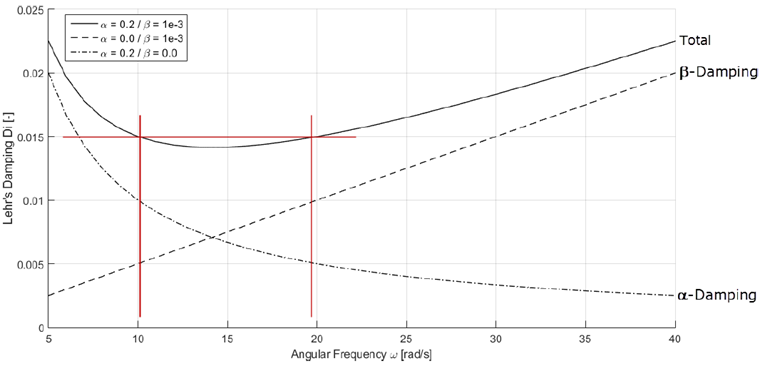The Damping tab includes various setting options to consider viscous structural damping in the linear time history analysis.
Damping
If the linear implicit Newmark analysis has been specified in the Main tab, only the Rayleigh "damping type" is available. For the linear modal analysis method, the list provides two options:
- Lehr's damping | Constant
- Rayleigh
When applying the Rayleigh damping to a linear modal analysis, the Rayleigh damping coefficients α and β are converted to the Lehr's damping values Di (see Parameters). The solution is then clear.
In the case of the Rayleigh damping, it is possible to determine the damping parameters automatically from the Lehr's damping. For this, select the "Calculate from Lehr's damping" check box. Then, enter the parameters of the two most dominant mode shapes for the "natural frequencies" f1 and f2 of the model with the corresponding values for the 'Lehr's damping' D1 and D2.
In the lower section, the "Natural Frequencies – Damping Diagram" is displayed for the Rayleigh damping. It represents the ratio between the natural angular frequency and the Lehr's damping constant.
Parameters
In this section, you can define the parameters of the damping. They differ depending on the damping type.
Lehr's Damping
The Lehr's damping is defined by the "Lehr's damping constant" D. It is defined for each individual shape i as a factor between the existing and the critical damping as follows:
|
ci |
Einträge in der diagonalen Dämpfungsmatrix |
|
mi |
Modalmassen |
|
ωi |
Kreisfrequenzen des Systems |
The damping matrix C must be a diagonal matrix.
Rayleigh
The damping matrix of the Rayleigh damping is defined by two damping parameters α and β as follows:
The damping matrix C does not necessarily have to be a diagonal matrix for the direct time history analysis. More information about the Rayleigh damping can be found in [1], for example.
The following relation exists between the Rayleigh coefficients and the Lehr's damping:
This equation is displayed in the following graphic. Different constellations for the damping parameters α = 0.2 and β = 0.001 are taken into account.
Different Lehr's damping values result for each pair of the Rayleigh coefficients. They depend on the angular frequency.

